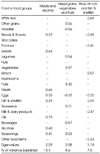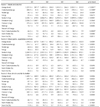1. Buyck JF, Blacher J, Kesse-Guyot E, Castetbon K, Galan P, Safar M, Hercberg S, Czernichow S. Differential associations of dietary sodium and potassium intake with blood pressure: a focus on pulse pressure. J Hypertens. 2009; 27(6):1158–1164.
2. Esmaillzadeh A, Kimiagar M, Mehrabi Y, Azadbakht L, Hu FB, Willett WC. Fruit and vegetable intakes, C-reactive protein, and the metabolic syndrome. Am J Clin Nutr. 2006; 84(6):1489–1497.
3. Flint AJ, Hu FB, Glyn RJ, Jensen MK, Franz M, Sampson L, Rimm EB. Whole grains and incident hypertension in men. Am J Clin Nutr. 2009; 90(3):493–498.
4. Han BK, Kang YM, Ju SH, Shin MY, Kim JM, Rha SY, Joung KH, Lee JH, Kim KS, Kim HJ, Ku BJ. Effects of green whole grain mixed diet on body weight and waist circumference in patients with type 2 diabetes. Korean J Obes. 2014; 23(1):41–49.
5. Hoffmann IS, Cubeddu LX. Salt and the metabolic syndrome. Nutr Metab Cardiovasc Dis. 2009; 19(2):123–128.
6. Hong SY, Song YJ, Lee KH, Lee HS, Lee MS, Jee SH, Joung HJ. A fruit and dairy dietary pattern is associated with a reduced risk of metabolic syndrome. Metabolism. 2012; 61(6):883–890.
7. Hu FB. Dietary pattern analysis: a new direction in nutritional epidemiology. Curr Opin Lipidol. 2002; 13(1):3–9.
8. Jones JM, Reicks M, Adams J, Fulcher G, Weaver G, Kanter M, Marquart L. The importance of promoting a whole grain foods message. J Am coll nutr. 2002; 21(4):293–297.
9. Kang M, Joumg HJ, Lim JH, Lee YS, Song YJ. Secular trend in dietary patterns in a Korean adult population, using the 1998, 2001, and 2005 Korean National Health and Nutrition Examination Survey. Korean J Nutr. 2011; 44(2):152–161.
10. Kant AK. Dietary patterns and health outcomes. J Am Diet Assoc. 2004; 104(4):615–635.
11. Kim JH, JO IH. Grains, vegetables, and fish dietary pattern is inversely associated with the risk of metabolic syndrome in South Korean adults. J Am Diet Assoc. 2011; 111(8):1141–1149.
12. Lee S, Park HS, Kim SM, Kwon HS, Kim DY, Kim DJ, Cho GJ, Han JH, Kim SR, Park CY, Oh SJ, Lee CB, Kim KS, Oh SW, Kim YS, Choi WH, Yoo HJ. Cut-off Points of waist circumference for defining abdominal obesity in the Korean population. Korean J Obes. 2006; 15(1):1–9.
13. Lee SY, Park HS, Kim DJ, Han JH, Kim SM, Cho GJ, Kim DY, Kwon HS, Kim SR, Lee CB, Oh SJ, Park CY, Yook HJ. Appropriate waist circumference cutoff points for central obesity in Korean adults. Diabetes Res Clin Pract. 2007; 75(1):72–80.
14. Lee TY, Yoo HJ, Joo NS. Daily calcium intake and obesity in middle-aged Koreans. Korean J Obes. 2009; 18(2):59–64.
15. Lim HJ. A study on the sodium and potassium intakes and urinary excretion of adults in Busan. Korean J Community Nutr. 2012; 17(6):737–751.
16. Lim S, Shin H, Song JH, Kwak SH, Kang SM, Yoon JW, Choi SH, Cho SI, Park KS, Lee HK, Jang HC, Koh KK. Increasing prevalence of metabolic syndrome in Korea: the Korean National Health and Nutrition Examination Survey for 1998-2007. Diabetes care. 2011; 34(6):1323–1328.
17. Moon HK, Kong JE. Assessment of nutrient intake for middle aged with and without metabolic syndrome using 2005 and 2007 Korean National Health and Nutrition Survey. Korean J Nutr. 2010; 43(1):69–78.
18. Mozumdar A, Liguori G. Persistent increase of prevalence of metabolic syndrome among U.S. adult: NHANES III to NHANES 1999-2006. Diabetes Care. 2011; 34(1):216–219.
19. Muzio F, Mondazzi L, Harris WS, Sommariva D. Effects of moderate variations in the macronutrient content of the diet on cardiovascular disease risk factors in obese patients with the metabolic syndrome. Am J Clin Nutr. 2007; 86(4):946–951.
20. National Cholesterol Education Program (NCEP), Expert Panel on Detection, Evaluation, and Treatment of High Blood Cholesterol in Adults (Adult Treatment Panel III). Third report of the National Cholesterol Education Program (NCEP) expert panel on detection, evaluation, and treatment of high blood cholesterol in adults (adult treatment panel III) final report. Circulation. 2002; 106(25):3143–3421.
21. Newby PK, Tucker KL. Empirically derived eating patterns using factor or cluster analysis: a review. Nutr Rev. 2004; 62(5):177–203.
22. Park YW, Zhu S, Palaniappan L, Heshka S, Carnethon MR, Heymsfield SB. The metabolic syndrome: prevalence and associated risk factor findings in the US population from the Third National Health and Nutrition Examination Survey, 1988-1994. Arch Intern Med. 2003; 163(4):427–436.
23. Riccardi G, Giacco R, Rivellese AA. Dietary fat, insulin sensitivity and the metabolic syndrome. Clin Nutr. 2004; 23(4):447–456.
24. Rizzo NS, Sabaté J, Jaceldo-Siegl K, Fraser GE. Vegetarian dietary patterns are associated with a lower risk of metabolic syndrome: the adventist health study 2. Diabetes care. 2011; 34(5):1225–1227.
25. Rumawas ME, Meigs JB, Dwyer JT, McKeown NM, Jacques PF. Mediterranean-style dietary pattern, reduced risk of metabolic syndrome traits, and incidence in the Framingham Offspring Cohort. Am J Clin Nutr. 2009; 90(6):1608–1614.
26. Sacks FM, Svetkey LP, Vollmer WM, Appel LJ, Bray GA, Harsha D, Obarzanek E, Conlin PR, Miller ER, Simons-Morton DG, Karanja N, Lin PH. Effects on blood pressure of reduced dietary sodium and the dietary approaches to stop hypertension (DASH) diet. N Engl J Med. 2001; 344(1):3–10.
27. Sahyoun NR, Jacques PF, Zhang XL, Juan W, McKeown NM. Whole-grain intake is inversely associated with the metabolic syndrome and mortality in older adults. Am J Clin Nutr. 2006; 83(1):124–131.
28. Shin KO, Oh SY, Park HS. Empirically derived major dietary patterns and their associations with overweight in Korean preschool children. Br J Nutr. 2007; 98(2):416–421.
29. Son SH, Lee HJ, Park K, Ha TY, Seo JS. Nutritional evaluation and its relation to the risk of metabolic syndrome according to the consumption of cooked rice and cooked rice with multi-grains in Korean adults: based on 2007-2008 Korean National Health and Nutrition Examination Survey. Korean J Community Nutr. 2013; 18(1):77–87.
30. Song YJ, Joung HJ, Paik HY. Socioeconomic, nutrient, and health risk factors associated with dietary patterns in adult populations from 2001 Korean National Health and Nutrition Survey. Korean J Nutr. 2005; 38(3):219–225.
31. Statistics Korea. The statistics of mortality and the causes. 2013. cited November 25, 2014. Available from
http://www.kostat.go.kr.
32. The Korean Nutrition Society. Computer Aided Nutritional Analysis Program 4.0 for Professionals. 2011.
33. Van dam RM, Rimm EB, Willett WC, Stampfer MJ, Hu FB. Dietary patterns and risk for type 2 diabetes mellitus in U.S. men. Ann Intern Med. 2002; 136(3):201–209.
34. Wirfält E, Hedblad B, Gullberg B, Mattisson I, Andrén C, Rosander U, Janzon L, Berglund G. Food patterns and components of the metabolic syndrome in men and women: a cross-sectional study within the malmö diet and cancer cohort. Am J Epidemiol. 2001; 154(12):1150–1159.
35. Yang EJ, Kerver JM, Song WO. Dietary patterns of Korean Americans described by factor analysis. J Am Coll Nutr. 2005; 24(2):115–121.
36. Yoo H, Kim YH. A study on the characteristics of nutrient intake in metabolic syndrome subjects. Korean J Nutr. 2008; 41(6):510–517.







 PDF
PDF ePub
ePub Citation
Citation Print
Print




 XML Download
XML Download